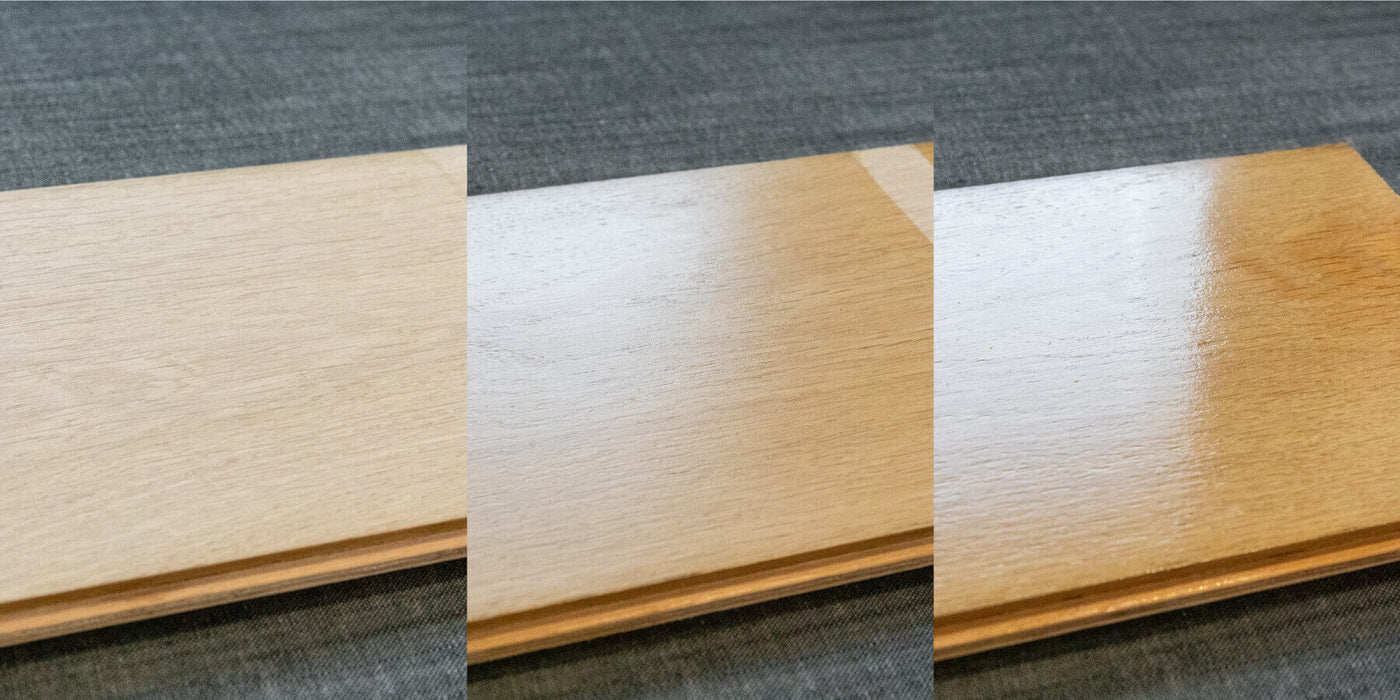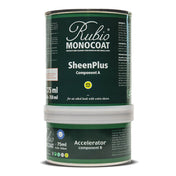What is sheen or gloss?
Wood sheen and gloss terminology are often used interchangeably, but they are actually different.
Sheen levels can be thought of as categories that house varying levels of gloss.
Common wood sheens are matte, satin, semi-gloss and gloss. Specific gloss levels are referred to using a numerical value. We'll dig deeper into this in a moment.
Unfortunately, it can be a little confusing picking out a sheen these day. Different manufacturers create names for a specific gloss level in a coating they produce. A satin (the actual gloss-level) from one manufacturer may be different from another's satin sheen. There is nothing wrong with that, but it creates a lot of confusion and frustration in sourcing a certain coating gloss-level.
Once you understand gloss-levels, you will be able to avoid this confusion.
The MPI (Master Paint Institute) has created gloss-level categories. With those standards, specifiers and applicators can select a certain gloss level more accurately regardless of the manufacturer.
Gloss levels can often be found specified in the Technical Data Sheet of a specific coating product.

Four different sheens shown on a plank of white oak flooring.
How gloss is measured
Gloss is typically measured with a gloss meter.

Photo Credit: PCE-Instruments
A gloss meter projects a beam of light, typically at a 60-degree angle, on a surface. Deflected light gets captured in a receptor. The amount of deflected light that is captured gets expressed in units from 0 (no gloss) to 100 (perfect mirror-like – highest possible gloss).
With very low gloss levels (like a matte finish), a 60-degree angle is often too great to measure deflected light very accurately. Therefore, an 85-degree angle setting in the gloss meter is sometimes used for more accurate readouts.

Photo Credit: Measure what you see
Sheen variations in higher gloss-levels are not as noticeable by the human eye. In lower sheens, any gloss-level variation becomes much more apparent when viewed side-by-side.
Impact of film-build on sheen
Number of coats
With traditional film-forming wood finishes, sheen appearance is often affected by the number of coats applied. The more coats that are used, the shinier a surface appears with the same sheen product.
Thickness of coats
With traditional paints and clear finishes, it is often important to monitor the thickness of each finish coat application. A thicker applied coat will exhibit a higher sheen than a thinner applied coat with the same product. This has to do with how the matting agents are distributed and oriented in the wet surface of the applied coat.
Clarity
The clarity of a clear finishing system in a matte sheen is often affected due to the matting agents and typically lacks depth and appears milky/cloudy when compared to a higher sheen in the same product. Of course, if the product does not build up, and is naturally matte, no matting agents are required and do not affect the clarity.
Color
With a darker colour stain, the colour experience is usually such that a matte clear topcoat results in a lighter appearing colour. A matte sheen typically appears greyish/cloudy in colour over a black stain even though a black stain colour is underneath the clear coat.
Therefore, you typically get better clarity and colour when at least a satin or semi-gloss sheen is selected as a finish coat over dark stains.
Texture
When traditional film-building coatings are applied to wood, you will lose and conceal the wood's natural grain feel and texture. A finish that allows you to experience the natural grain, feel and texture has become desirable again when finishing wood substrates.
Forget the film-build
Not all wood finishes build a film on the surface. This means that you can't build multiple coats or change the thickness of the coats to influence the sheen. This naturally lends itself to lower sheen levels. It also means that you do not have to worry about negatively impacting the clarity, colour or texture of the wood.
With a hardwax oil wood finish like Rubio Monocoat Oil Plus 2C, you typically achieve a beautiful matte sheen (about 4 units measured at a 60-degree angle). This results in a natural appearance that does not lose its natural grain feel and texture while achieving great clarity and durability.
To increase the sheen on a surface finished with Oil Plus 2C, use Universal Maintenance Oil. This will increase the gloss level to about 8-12 units.
While a gloss level of 8-12 units is still considered a matte finish, the 50% gloss level increase will be very noticeable and often satisfies a customer who desires a bit higher sheen/gloss.
Another product used to increase the sheen of Oil Plus 2C finished surfaces is SheenPlus, which results in a durable satin look.
Gloss and Sheen Standards
In the past, the coating industry identified sheens typically as matte, eggshell, satin, semi-gloss, and gloss.
Most manufacturers still use these identifiers, but variations in gloss-level in each sheen are common.
The MPI has therefore created the below Gloss and Sheen Standards:
| MPI Gloss & Sheen Standards | Description | Gloss @ 60° | Gloss @ 85° |
|---|---|---|---|
| Gloss Level 1 | a traditional matte finish – flat | max. 5 units | max. 10 units |
| Gloss Level 2 | a ‘velvet-like’ finish | max. 10 units | 10-35 units |
| Gloss Level 3 | a traditional ‘eggshell-like’ finish | 10-25 units | 10-35 units |
| Gloss Level 4 | a ‘satin-like’ finish | 20-35 units | min. 35 units |
| Gloss Level 5 | a traditional semi-gloss | 35-70 units | |
| Gloss Level 6 | a traditional gloss | 70-85 units | |
| Gloss Level 7 | a high gloss | > 85 units |
Common sheen levels
Let's take a closer look at some of the common sheens and when they are typically used. Each sheen level will have its own features and benefits.

Matte finish shown on white oak flooring.
Matte
With a gloss level of < 5 units, matte sheens offer the lowest level of gloss and allow the wood to retain a natural look.
Matte finish hides most substrates imperfections. For instance, most ceiling paint is matte in sheen as it hides installation, preparation, and finishing blemishes.
Scratches are hidden quite well in a matte finish. If you were to compare the same scratch across the various sheen levels, the matte surface would hide the scratch the best.
It is known that matte paints are not as easy to keep clean. But why is this? They are often manufactured with a high pigment-volume concentration (PVC) which results in a relatively coarse surface that picks up dirt easily. Recent advancements in coating technology are working towards making matte/flat coatings more dirt-resistant and easier to wash.
You’re in luck! Rubio Monocoat Oil Plus 2C is a wood finish with a matte sheen. It keeps the natural look and feel of the wood, hides imperfections and scratches well, but does not have a high PVC! Therefore, it does not have the course surface like a traditional matte finish and is easy to clean.

Satin finish shown on white oak flooring.
Eggshell and Satin
With a gloss level of approximately 20-35 units, this is a popular option with film-building wood floor finishes. Many manufacturers have varying gloss levels in these sheens.
Eggshell sheens require more preparation level to achieve a smooth and flat surface. However, it can be forgiving in showing surface and preparation shortcomings.
A satin sheen requires a bit more surface preparation skill as the higher sheen is less forgiving in hiding blemishes.

Semi-gloss finish shown on white oak flooring.
Semi-gloss
This sheen level may range from 35-70 units, but most of the products ranges from about 45-60 units when dealing with wood finishes.
This sheen level shows a distinctly shinier finishing level. It requires more care during intercoat abrasion to avoid sanding scratches that are more noticeable in the finish coat.
It also shows dirt/dust/scratches easier and requires thicker build coats for the best appearance.

Gloss finish shown on white oak flooring.
Gloss and high gloss
These high sheen levels are also sometimes described as “piano-top” finishes.
They require careful and perfect preparation for the best results. They show any substrate preparation blemish or sanding scratch in the finish.
Gloss/high gloss finish is commonly used for gym floor finishing and bowling lanes or modern high-end cabinetry and furniture.
These high sheens show dirt/dust/scratches very quickly. They require frequent “screen and recoats” to maintain an acceptable finishing level on wood floors.
They require a significant number of coats for a good high gloss sheen.
Any scratching or wear will show as a whitish/chalky blemish.
Automotive finishes are typically also very high gloss, with over 95 units of gloss level.
Glossy finishes are not popular on residential wood floors. Current sheen preferences are trending towards lower sheen or matte finishes.
Share on social!
Varying wood sheens shown on white oak flooring.


